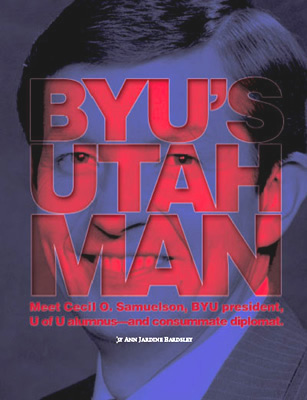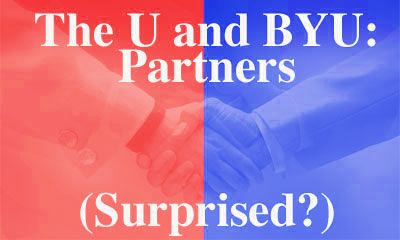|
||||||||||
|
If there is ever to be a bridging of the intense rivalry between the University of Utah and Brigham Young University (BYU), surely it has now come in the form of Cecil O. Samuelson, professor, physician, and administrator at the U for many years, who, last May, became the 12th president of BYU. Consider:
His allegiance straddling the two universities, Samuelson now leads more than 29,000 BYU students, 98 percent of whom are members of The Church of Jesus Christ of Latter-day Saints. In this role, Samuelson, 62, will report on the health of the private school to Church President Gordon B. Hinckley BA’32. Since his appointment, colleagues, friends—even neighbors— have jibed “Cec”(pronounced “seese”), as they call him, about his blood turning from red to blue. As Fred Esplin MS’74, the U’s vice president for university relations and a longtime friend of Samuelson’s, noted, with a smile, at his appointment, “We applaud the leadership of the Church for its wisdom and foresight in choosing someone so well-credentialed in his education as Cec as the new president of BYU.”
“My feelings for the University of Utah have not lessened one whit,” Samuelson explains diplomatically. “I love BYU, and I love what I’m doing. I think it’s exciting and wonderful, and I anticipate it will be terrific. But it doesn’t mean that suddenly my feelings for, my appreciation of, and my gratitude for all that occurred to me in my experiences at the University of Utah have lessened in any way.” Sharon Giauque Samuelson BS’64, who graduated from the U in history education, laughs and says rumors that she has U of U license plates, a shrine to the U in the basement, and a red block U at the bottom of a swimming pool are not true. She says the Samuelsons equate their feelings for the U and the Y to feelings parents have for their children: “We don’t love the first child more than the third,” she clarifies matter-of-factly. President Hinckley calls Samuelson a “consummate administrator.” Indeed, Samuelson’s broad range of experiences serving in academic, private sector, and spiritual leadership positions make him uniquely qualified for the BYU job. “When I left the U administration, I closed a chapter of my life, but my background there was very helpful,” Samuelson says. “I find myself very comfortable with issues of quality and standards here at BYU.” The eldest of five children, Samuelson is a Salt Lake City native and graduate of Granite High School. As a teenager he worked at Skyline Floral, in construction, and as a janitor, “all the usual kinds of jobs,” he remembers. “One of the things my dad did for me that I have most appreciated—that I didn’t at the time—is he taught me how to work hard. Saturdays we always worked. I used to be irritated that some of my friends cut the lawn but didn’t have other projects. We always had projects. Later my dad and I built a boat, a motor home, and a couple of houses, including my own. Building things was his way of helping us learn how to work.” Samuelson spent much of his time during his early years on campus with his father, whom he calls his “most consistent mentor.” As a freshman, he declared engineering as his major, but soon discovered that he was more interested in “people engineering” and switched to molecular genetic biology. Despite his academic accolades, Samuelson says he wasn’t a stellar student, although he admits he belonged to all the “right” honor societies and earned the “right” awards. After receiving his M.D. from the U, he fulfilled his residency and held a fellowship in rheumatic and genetic diseases at Duke University Medical Center—the last job for which he applied. In 1973 Samuelson returned to the University as a faculty member. He became dean of the School of Medicine and then vice president for health sciences. He has received numerous scholastic honors and is the author or co-author of 49 original publications, eight books or chapters of books, and 13 abstracts. The University’s School of Medicine recently presented him with its Distinguished Alumnus award. In 1990 Samuelson left the U to become an administrator at Intermountain Health Care (IHC), first as senior vice president for medical affairs, then IHC senior vice president, and, in 1993, president of IHC Hospitals, Inc. Throughout his life Samuelson has been devoted to the LDS church and has emphasized that faith and academics are not mutually exclusive. He has been a stake high councilor, branch president, stake president, regional representative, and president of the Utah North Area and the Europe North Area of the Church. In 1994, while at IHC, he was called by the Church to be a full-time member of the First Quorum of the Seventy. At the time of his assignment to BYU, he was a member of the Presidency of the Seventy and general president of the Sunday School. Former University President Chase Peterson, who selected Samuelson to replace him as vice president of health sciences in his administration, calls him a “very bright guy,” someone who, Peterson says, “can get the job done. Cec is always aware of the larger significance of something and doesn’t get lost in the details. He is a very good medical doctor, which is important because it means he can relate well to people. He has a wonderful sense of humor. He can laugh at himself and he can chuckle at the foibles of mankind. I say ‘chuckle’ because he is never cruel with humor or with the weaknesses that he and all the rest of us have; but he can see the humorous side of all that we do. He is a really fine guy.”
The Samuelsons have five children, including twins adopted from Guatemala, and are grandparents to three. (Two of their five children are U graduates; one attended Salt Lake Community College; a son-in-law is attending the Y’s business school; and their youngest is currently a student at the U.) Sharon describes her husband as loyal, dependable, spiritual, and sharp-witted, with the ability to make people laugh. That he is a man of his word, puts his family first, and values her independence is what she likes best about him. “He is an achiever, but he can also relax,” she says. Janet Calder and Jan Ekeroth, Samuelson’s BYU assistants, immediately noticed his commitment to his work at the university. “He arrives early and stays late, making the most of every minute of his time,” they observe. In fact, time, or “trying to fit everything that needs to be accomplished into the day,” notes Sharon, is his greatest challenge. When he has free time, Samuelson enjoys reading and calls his preferred subject matter “fairly catholic,” although he tends to gravitate toward histories and biographies. He writes his own speeches and is a self-proclaimed “news junkie.” Naturally, the hard-working Samuelson advises all students—
whether at the U or BYU—to work as hard as they
can, keep an open mind for as long as they can about career
options, and recognize that the college years are “idyllic,”
when one-time opportunities present themselves. Of his
own life’s education, he says, “My life has been so much
richer in so many ways than I could have ever anticipated.” —Ann Jardine Bardsley BA’84 is a writer in the U’s public relations office. |
||||||||||
|
Supporters of the U and the Y recognize the Utes and Cougs have a few things in common: campus parking challenges, a love of Krispy Kreme doughnuts, rabid athletic fans, and the same founder, Utah’s first Territorial Governor Brigham Young. In fact, the scope of the collaborative efforts between the two schools might surprise followers of the red and the blue: • The Utah-BYU Food Drive, now in its 10th year, is sponsored by the schools’ Alumni Associations and is held for the two weeks prior to the Utah- BYU football game. Last year truckloads of food and more than $7,500 were donated to the Utah Food Bank. Recently both schools jointly received the Council for Advancement and Support of Education’s (CASE) Seal of Excellence Award, which recognizes outstanding community service and showcases the project as a model to other schools. • The Advanced Combustion Engineering Research Center (ACERC) is a joint U-BYU research organization that draws upon the combined talents and resources of the two schools in the area of applied combustion research. One example is a U.S. Department of Energy (DOE)-sponsored grant at the U—“The Investigation of Fuel Chemistry and Bed Performance in a Fluidized Bed Black Liquor Steam Reformer”—that provides technical support for a $90 million commercial demonstration of the gasification of “black liquor,” a byproduct of paper production and a renewable fuel source. The two schools have been actively collaborating on joint combustion research through ACERC for more than 15 years. • The KBYU/Utah Colleges Exit Poll, directed by BYU’s political science department and now in its 21st year, provides University and BYU student volunteers the opportunity to participate in the extensive election-day project, the results of which are released on KBYU after polls have closed. • Founded last year, The Campaign Legal Center was created to act as the “people’s voice” in administrative hearings and proceedings on campaign finance and media laws. The center is managed through the U’s Campaign and Media Studies Program, created to support and develop areas of inquiry and action on these issues through academic research, conferences, and internship programs. BYU faculty participate in conferences and collegial programs. • For more than a year, U of U and BYU investigators have been working with the University’s John A. Moran Eye Center, studying different aspects of macular degeneration, the most common cause of age-related vision impairment. Five researchers (two at BYU and three at the U) are working to understand several aspects of the disease. Collaboration allows them to share information, different expertise, and samples between their labs. |
||||||||||

 That
school to the south. Co-ed jokes. 34-31. Football “Holy War.”
Utah by five! BYZoo.
That
school to the south. Co-ed jokes. 34-31. Football “Holy War.”
Utah by five! BYZoo.